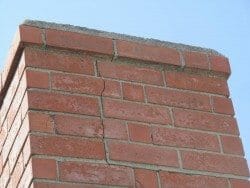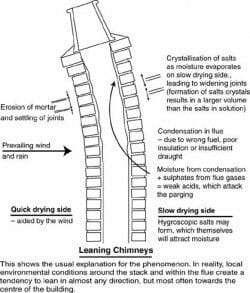Chimney Cracks – Serious or Not
Home » Furnaces, AC's & Fireplaces » Chimneys »

Cracks in chimneys usually occur because of freezing – thawing weather issues, footing and soil issues or lack of maintenance. Areas with earthquake trimmers will likewise experience more cracking than stable areas.
The cracking in brick or stone chimneys may be in the brick or stone itself, in the mortar or both. Overall, brick and stone chimneys are very durability and usually last for many years when compared to other materials.
Maintenance
Generally small cracks and mortar deterioration are considered to be a maintenance issue and can easily be repaired. It is a good practice to keep cracks sealed so that moisture does not penetrate into them, especially in cold climates where the water penetrates into a crack and then freezes. This is because when water freezes, it expands and this will cause the brick or stone to spall or to have additional cracks.
Vines growing on chimneys have small roots that will penetrate cracks. This penetration cause the brick or mortar to become damaged and over time can create significant damage. Although people may like the look of vines on a chimney and think that they add charm; in reality the vines may be damaging their chimney.
Crack causes
Movement of pad or footing relating to soils
If the soils under the chimneys pad or foundation has a poor load bearing capacity, is expansive or has settled, then there is a fair chance that cracking of the chimney will occur.
Lack of proper maintenance
Grout joints and brick require maintenance periodically. Failure to do proper sealing or re-pointing from time to time can contribute to cracking.
Freezing and thawing
Weather in cold climates where there is freezing and thawing is hard on brick and stone fireplaces. Once water migrates into small cracks and freezes, the cracks usually get larger and larger. Keeping cracks properly sealed is an important part of maintaining a fireplace chimney.
Earthquakes
In major earthquakes the news channels often have film footage of chimneys that have fallen over; sometimes on cars or onto neighbors property. What they don’t show you is that small trimmers can generate cracks and damage to chimneys, but the chimneys are still standing.
Thermal damage
Large hot fires in a fireplace with no liner or a damaged liner may cause cracking. Another source of extreme heat may be from a chimney that has a creosote buildup that catches fire. Heat from grass and tree fires or a house fire can likewise cause cracking.
Trees, antennas
Tree with large roots systems can crack or damage a pad under the chimney. Large branches that crash against a chimney during a storm can cause damage. Homes with large or high antennas on the chimneys can generate a lot of pressure, especially on tall chimneys during wind storms.
Poor drainage
When the area near the chimneys footing allows water to puddle or doesn’t slope away from the chimneys base, then settlement or expansion issues may arise. This may cause the foundation to move and cracking to occur.

Significant Cracks
Cracks that appear to be severe should be looked at by a chimney specialist to determine if they are serious or just a maintenance or cosmetic issue.
Ones that are offset, wide or that has smoke stains should especially be reviewed. ( Read about CHIMNEY INSPECTIONS AND INSPECTORS )
Tip
Surprisingly, buyers and homeowners, can do two easy things that will greatly help reduce damage to their chimney.
- Make sure that water does not stand or puddle near the chimneys pad or footing. Ideally the soil or area next to the chimney should slope away with a drop of approximately 6 inches in 10 feet.
- Sealing and maintaining the brick and grout to reduce water penetration into the brick and mortar.
Who to consult? Fireplace contractors and brick and stone masons.
Home owners will often touch-up or seal cracks in their chimney. Fireplace contractors, qualified handymen and brick masons are often skilled at working on chimneys.


